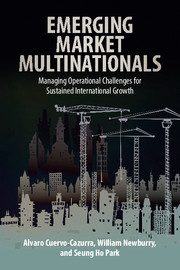Book contents
- Frontmatter
- Dedication
- Contents
- List of figures
- List of tables
- Foreword
- Preface
- List of abbreviations
- 1 Introduction: the rise of EMNCS
- 2 Understanding the challenges of internationalization
- 3 Country selection
- 4 Entry mode selection
- 5 Establishment
- 6 Operation
- 7 Integration
- 8 Expansion
- 9 Conclusions
- References
- Index
Foreword
Published online by Cambridge University Press: 05 March 2016
- Frontmatter
- Dedication
- Contents
- List of figures
- List of tables
- Foreword
- Preface
- List of abbreviations
- 1 Introduction: the rise of EMNCS
- 2 Understanding the challenges of internationalization
- 3 Country selection
- 4 Entry mode selection
- 5 Establishment
- 6 Operation
- 7 Integration
- 8 Expansion
- 9 Conclusions
- References
- Index
Summary
By now, companies from emerging markets have come to account for 25 percent of the Fortune Global 500, up from 2 percent in 1995. And it has been forecast – by academics as well as consultants – that their share will approach 50 percent by 2025. But whether that happens or not, companies from emerging markets have clearly already developed a significant presence on the list of the world's largest companies. This is presumably not unrelated to the recent surge of interest in them.
What tends to be underemphasized in such discussions, though, is that companies from emerging economies are still significantly less internationalized, in general, than their counterparts from advanced economies. Stick to the Fortune Global 500 list for concreteness. To an (even) greater extent than companies from advanced economies, companies from emerging ones have done well by doing well at home; that is, they are not quite as internationalized in terms of sales. They also tend to report lower levels of R&D-to-sales and advertising-to-sales ratios, although this is due in part to differences in sectoral mix (energy and natural resource companies loom particularly large in the emerging economy list). And companies from emerging economies also tend to be (even) more ethnocentric in terms of their top management and governance.
These patterns in the data do not seem to have weighed much on writings celebrating the arrival of emerging economy multinationals, although the dearth of data often constrains them to overrelying on the same handful of success stories. This book is different. It engages seriously with the operational challenges that underpin the data presented earlier – and that continue to confront emerging economy companies as they multinationalize. Despite its brevity, it draws on a broader range of company examples, considers a broader range of countries of origin, and is significantly less skewed toward depicting just success stories than other recent moves on the same topic. Conceptually, it dovetails with my calculations that there is significantly less distance (defined broadly to include cultural, administrative, and economic differences), on average, between emerging economies than between them and advanced economies, as well as the strategic implications of attempts to model the interactions between competitors from emerging economies and advanced ones.
- Type
- Chapter
- Information
- Emerging Market MultinationalsManaging Operational Challenges for Sustained International Growth, pp. xi - xiiPublisher: Cambridge University PressPrint publication year: 2016

